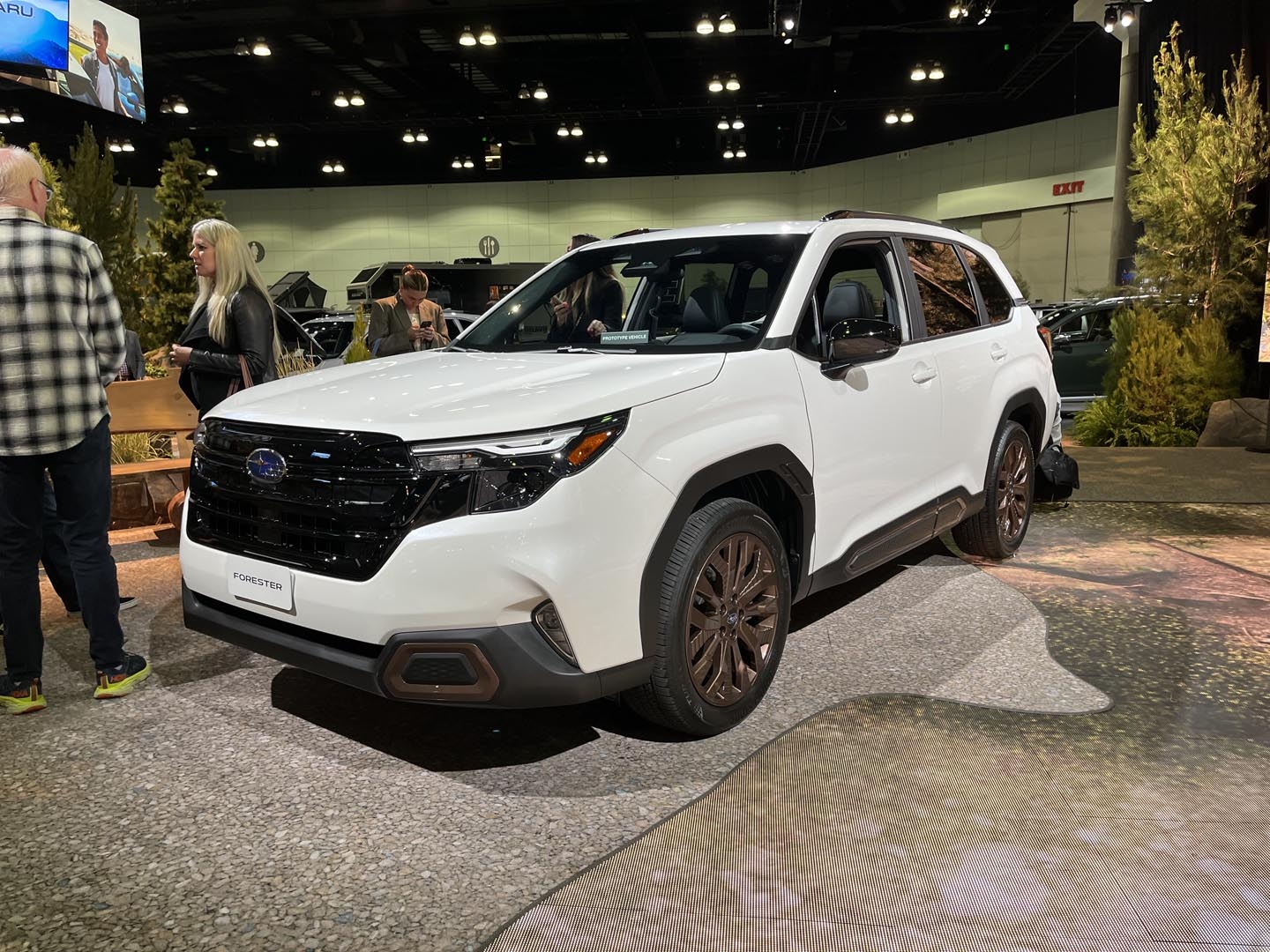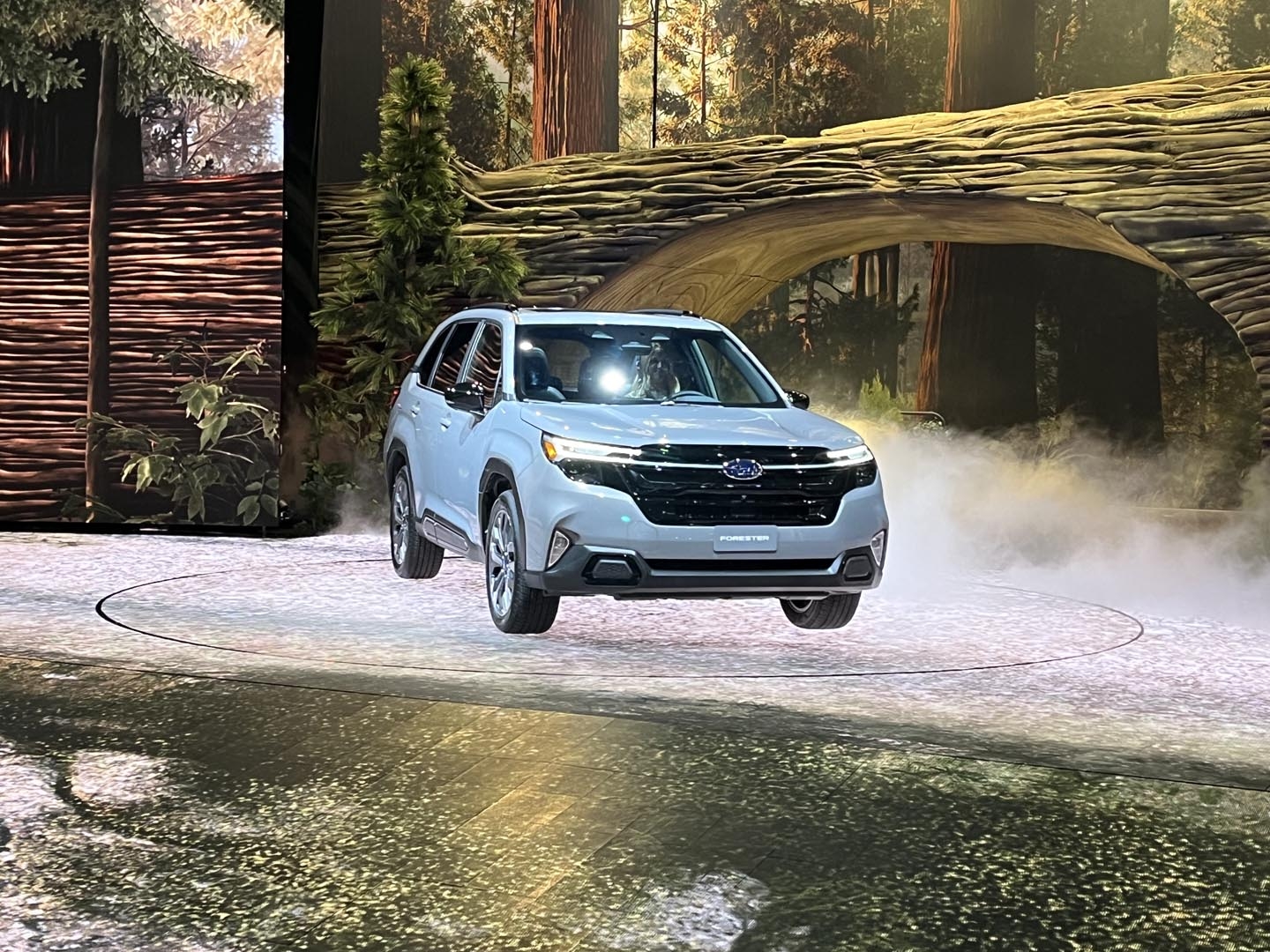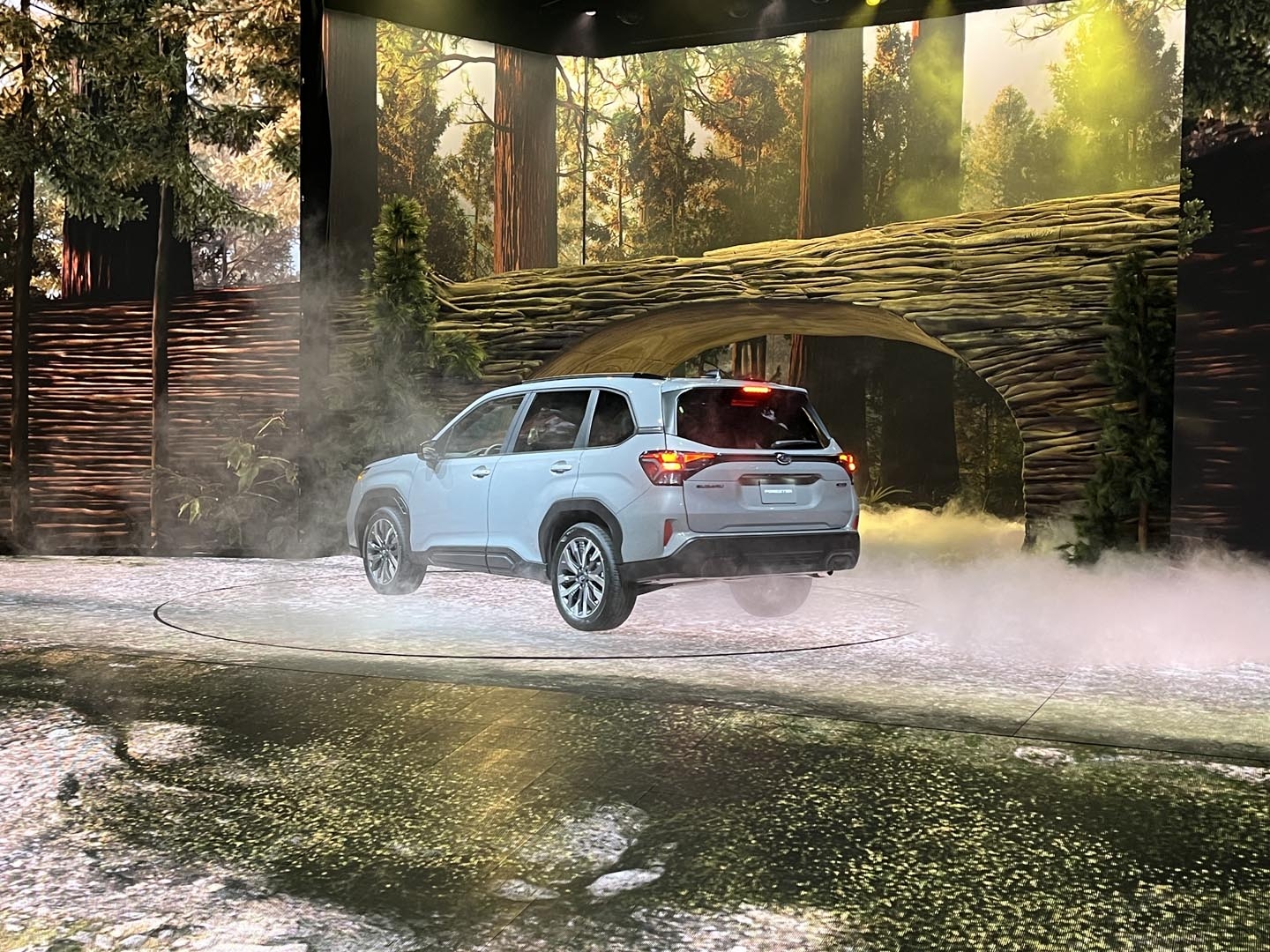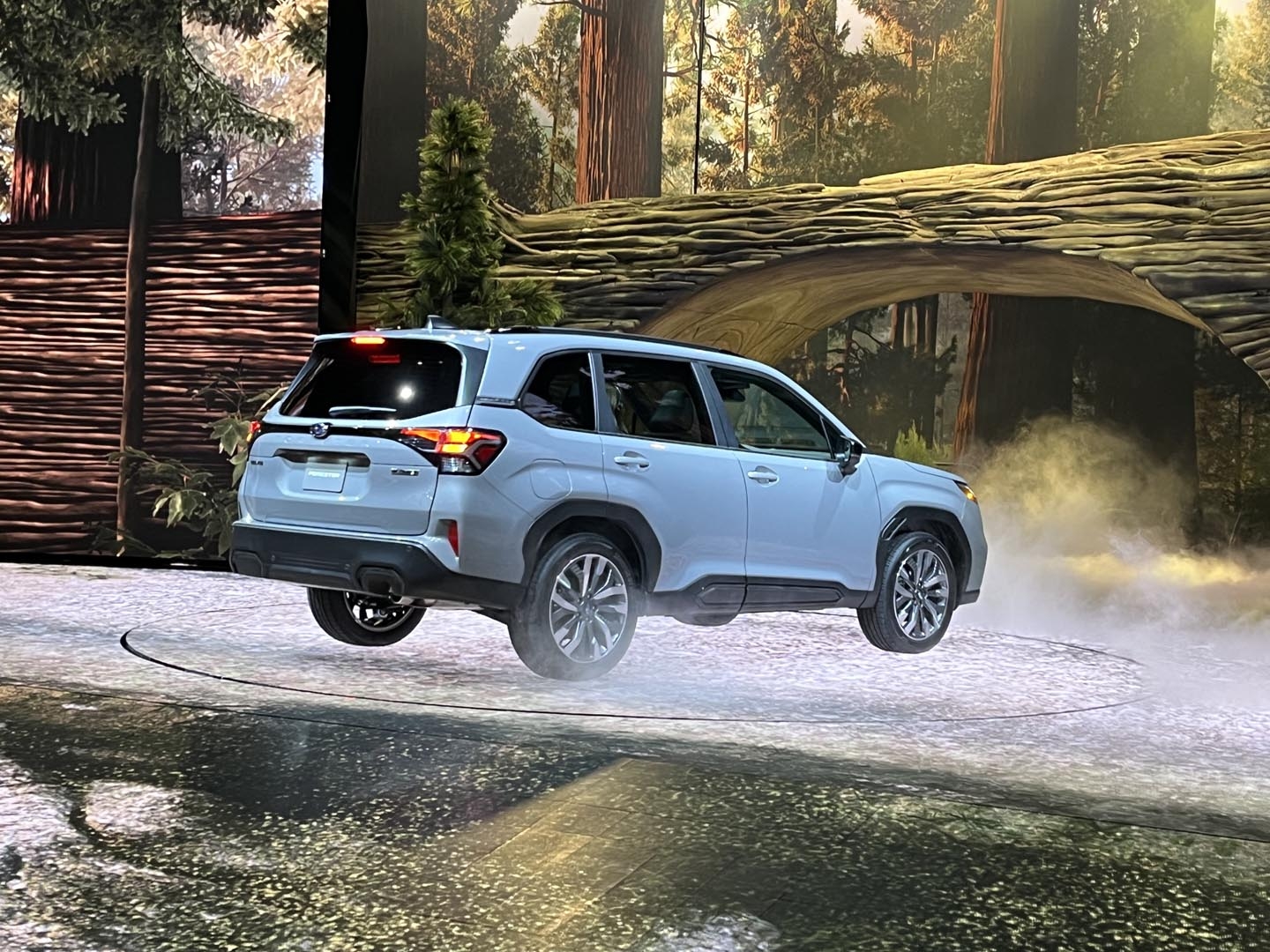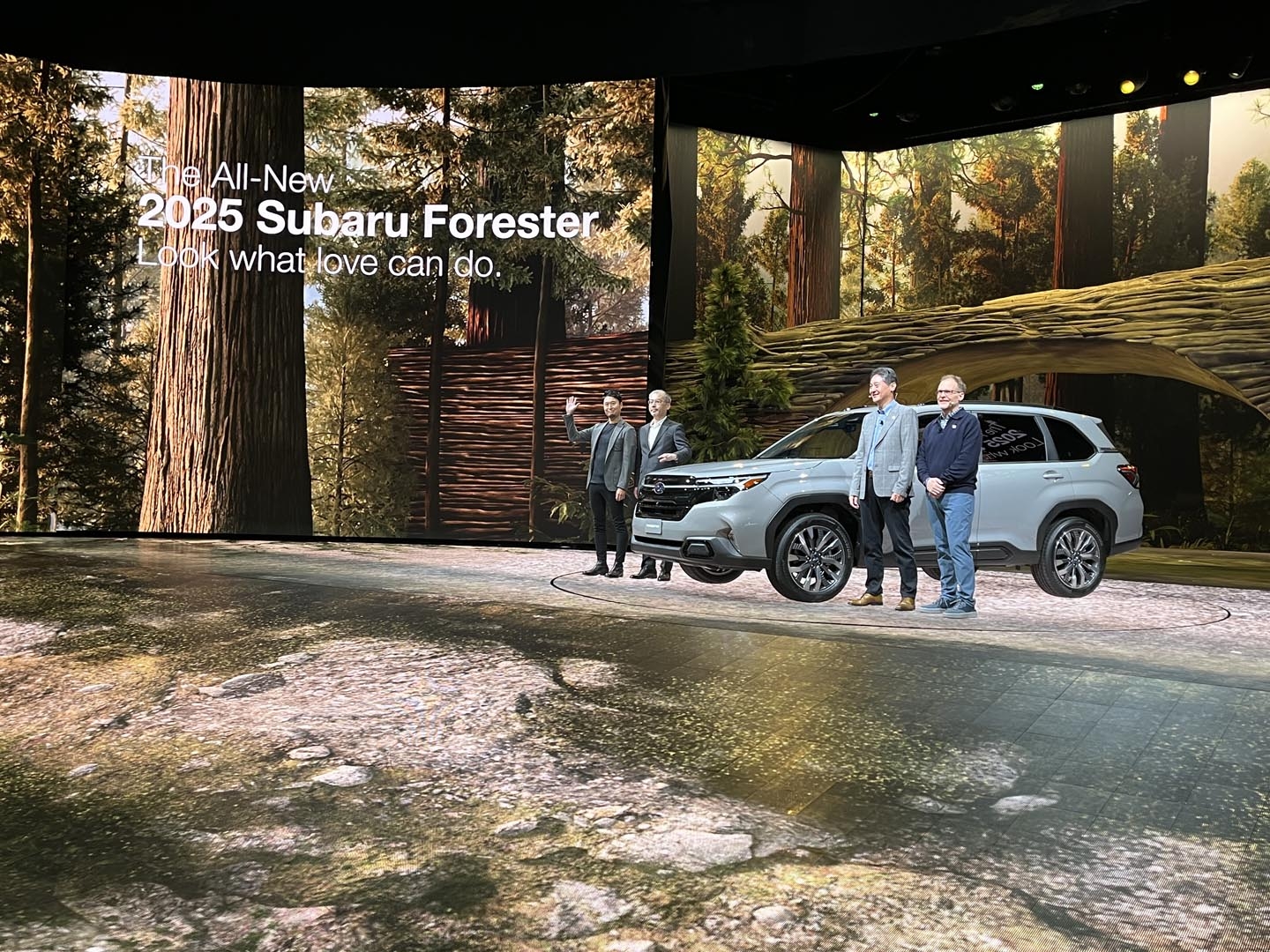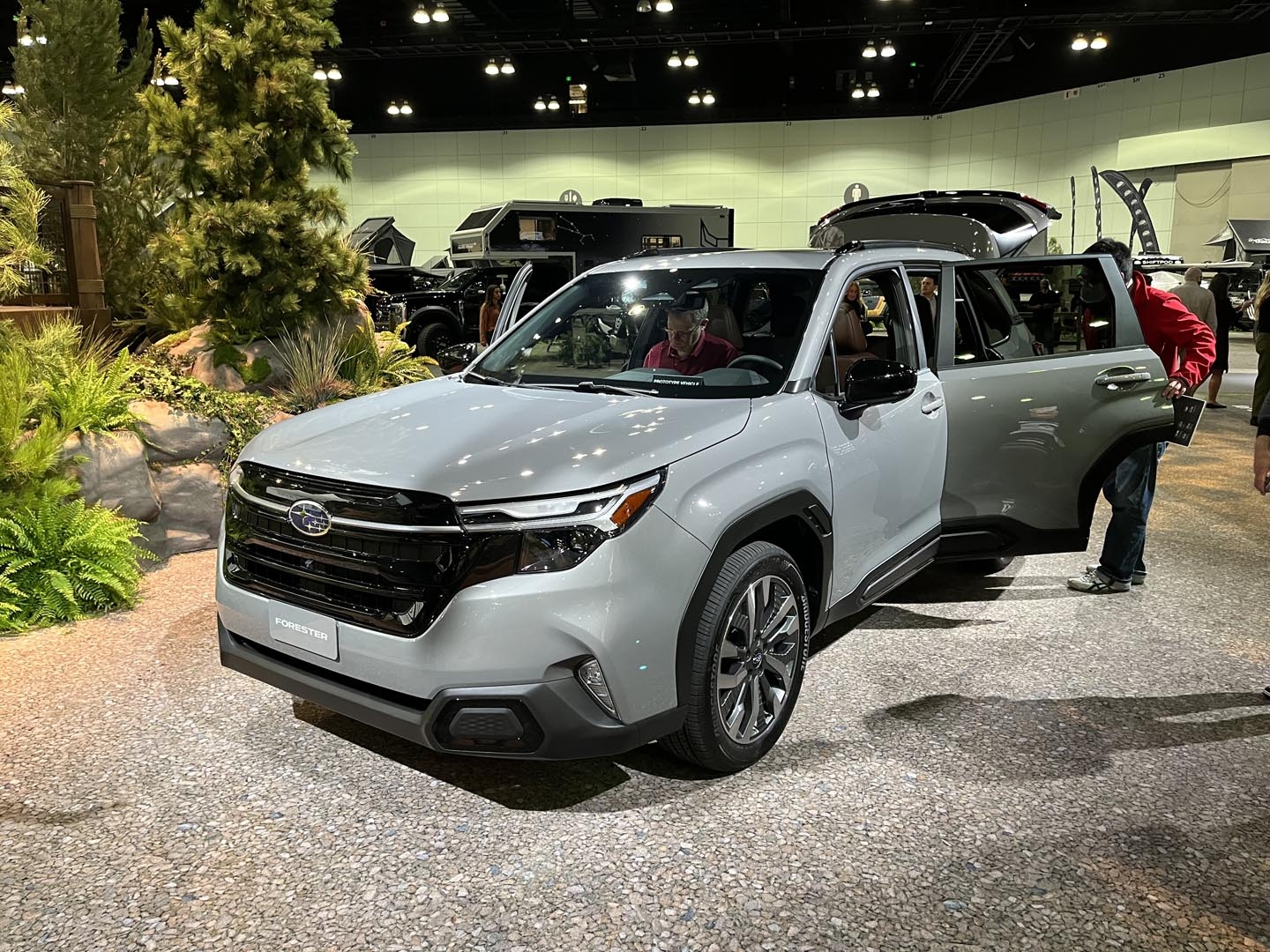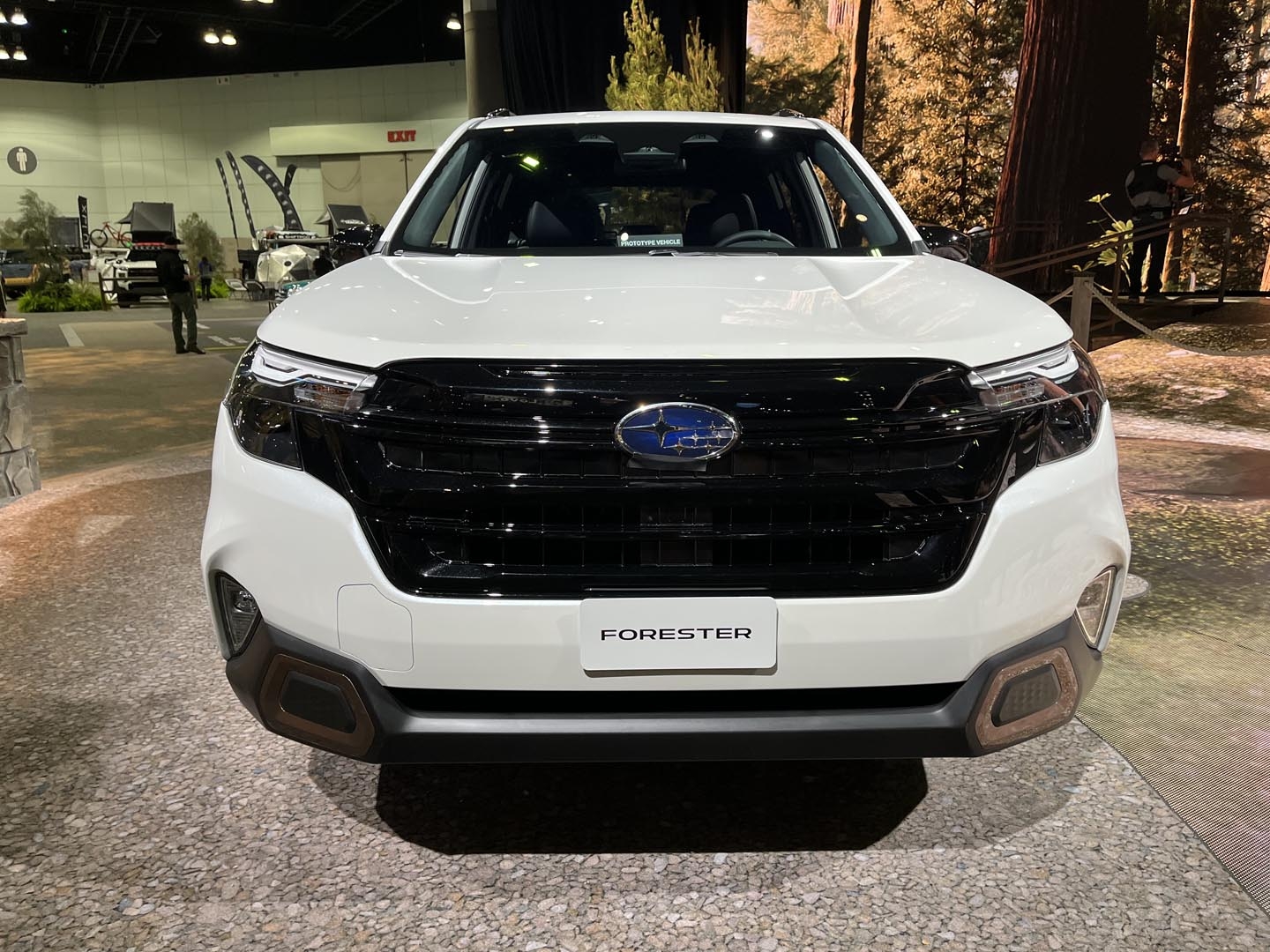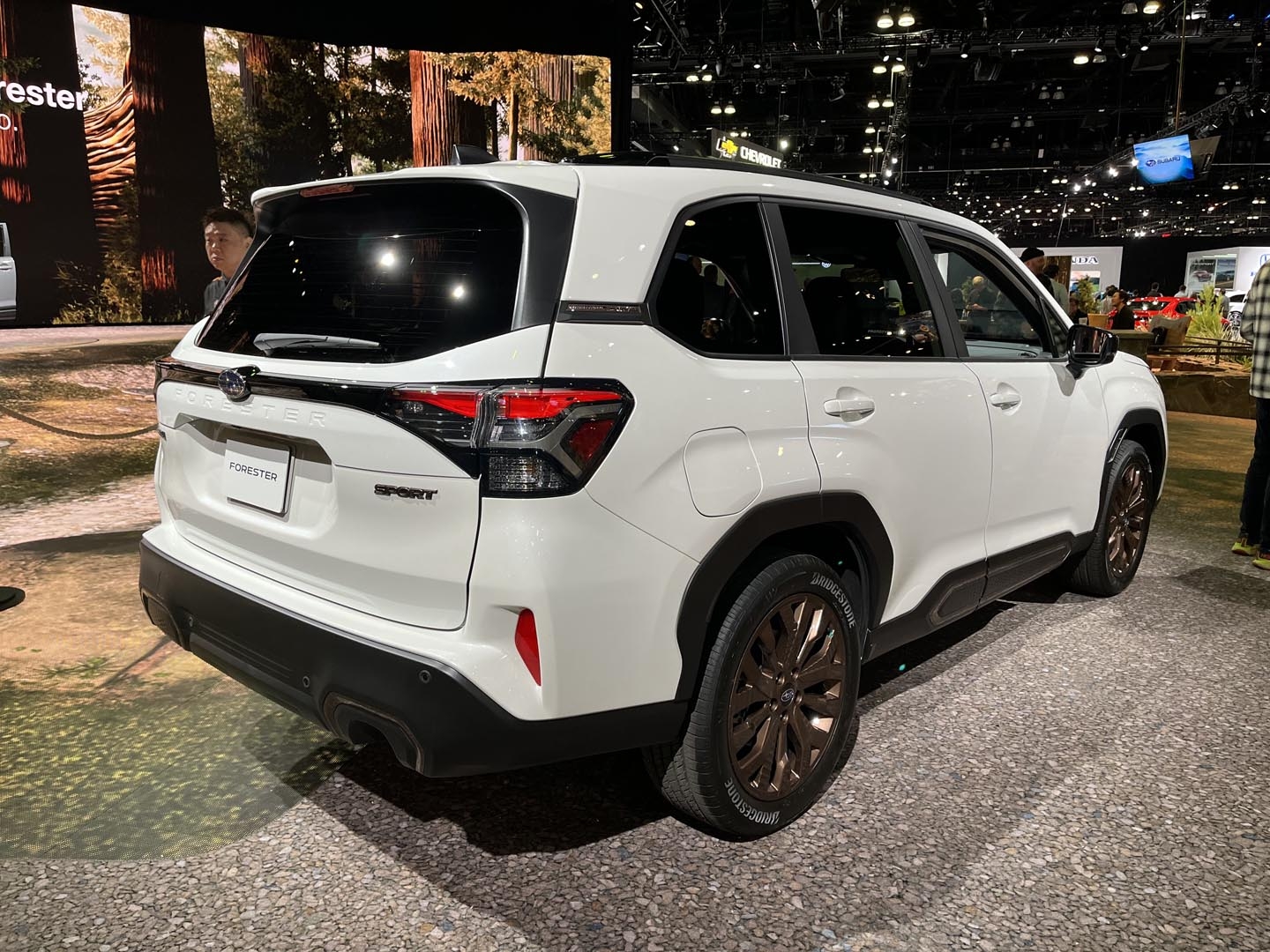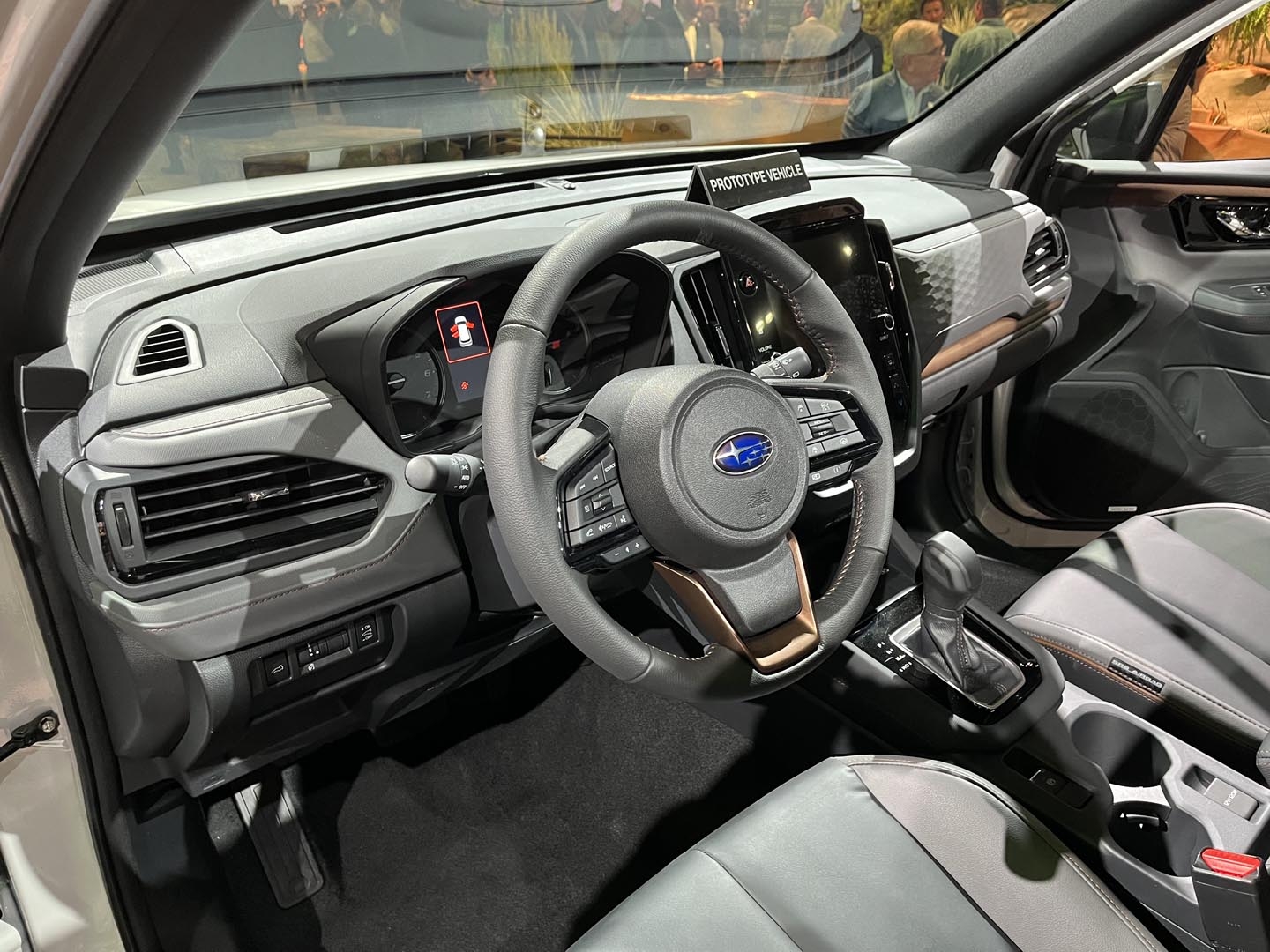
SUBARU Forester 2025
Pros and cons
Pros
- All-purpose passenger compartment
- Visibility preserved
- Field-proven all-wheel drive
- Promising mechanical refinements
- Upgraded standard equipment
- Hybrid version announced at last
Cons
- Overloaded 11.6-inch touchscreen
- Reliability varies, needs constant monitoring
- No blind-spot monitoring on base model
Overview
During the Los Angeles Auto Show, Subaru took the opportunity to unveil the sixth-generation Forester. A 2025 vintage, this fresh addition perpetuates Subaru’s long-standing tradition of evolution … at least, as far as the mechanical and interior aspects are concerned. Because this time around, the six-star brand dared to stray a little from its customary stylistic tenets. In a similar spirit of modernization, a hybrid version of its compact SUV is (finally) on its way, but not before another year.
Strictly combustion-powered units of the 2025 Forester will start shipping from Japan next spring. Pricing, fuel consumption ratings and full specifications will be revealed as we get closer to the market launch date.
We already know that the five usual variants—Convenience, Touring, Sport, Limited, and Premier—carry on, along with a revamped equipment list. The Convenience trim gains alloy wheels, a spoiler, rear USB charging ports and dual-zone automatic climate control. The Sport version features bronze tone accents rather than orange ones (including wheels), and offers the same Harman Kardon audio system as the more expensive Forester, as well as leatherette upholstery. The power tailgate on Touring and higher trims is improved with a foot-activated, hands-free opening. Finally, ventilated front seats and a surround-view camera system are added to the Premier version.
Subaru has not yet confirmed the comeback of its adventurous Wilderness model, but it wouldn’t come as a surprise if an announcement in this regard were to be made next year.
Verdict
A breath of fresh air, or just plain assimilation of the standards set by the Forester’s horde of rivals? We leave it to the public to decide. Nevertheless, we’re delighted that Subaru has managed to combine this dash of audacity with the safety, visibility, and versatility it has long treasured. Although we’re not expecting a revolution, we can’t wait to see for ourselves just how the many refinements the manufacturer claims will polish (or spice up?) the use of this vehicle, which is particularly well suited to driving in Quebec, albeit slightly watered down over the years.
Evaluation
Body, cabin and cargo space
Subaru states that the ground clearance and overall size of the redesigned Forester remain very similar to those of the outgoing generation. If it appears wider, this is largely due to its larger-than-ever grille and the many horizontal aesthetic flourishes that usher in a new visual signature for the automaker. Even the rear end has been slightly tapered to reduce the “narrow body” effect that has always characterized this model.
All in all, the new Forester has shed a little more of its tall station wagon character to become more akin to an SUV. Nevertheless, the manufacturer was keen to uphold some traditions, such as the extensive glass surface which should, in principle, ensure excellent visibility.
Likewise, the spaciousness and versatility associated with the outgoing generation feature prominently on the new model’s design. We were able to confirm this by “touring” the cabins of the two exhibits at the LA Auto Show in mid-November 2023. Families of four will fit comfortably inside, unless they attempt to install a bulky child seat behind a front bucket seat that’s pushed back to the maximum.
The automaker explains that the front seats are closely inspired by those of the 2024 Crosstrek, whose comfort seduced several CAA-Quebec test drivers.
Also according to Subaru, the tailgate opening width has been reduced by 5cm, yet remains significant and practically uniform from top to bottom. It still provides access to a compartment which itself is wide and long, and whose height under the headrests has been improved over time.
This is also true when it comes to the quality of materials and finish. The vehicles on display in Los Angeles were preproduction models, but their trims and assembly already felt meticulously crafted.
At first glance, however, the overall look remains very similar to that of the previous model, apart from a few visual nods embedded in the plastic of the dashboard and door sills. All versions, except the least expensive, still feature the majority of controls on an 11.6-inch touchscreen. Vertically oriented, the screen is better organized and faster since its last overhaul, which first appeared in the 2023 Legacy and Outback, as well as in the 2024 Crosstrek. Still, it remains crowded; Subaru would be well advised to bring back a number of physical buttons, especially for ventilation and some driver assistance functions.
On the other hand, a good old-fashioned floor gearshift sticks to the layout, as do a pair of analogue gauges paired with a small screen in front of the driver. This configuration doesn’t impress as much as a fully digital instrumentation, but it deserves the credit for being crystal clear.
Safety
Subaru lumps most of the usual driver assistance features under the EyeSight umbrella. Standard on the 2025 Forester, the fourth generation of this system features a wide-angle camera whose data completes that already acquired by the pair of symmetrical cameras underlying the system. Coupled with an electric power brake booster, this addition contributes to both quicker and smoother responses, claims Subaru.
In addition, a new emergency stop assist function can immobilize the vehicle if the driver fails to respond to the warnings emitted when the adaptive cruise control and active lane control system are activated. On Touring and higher versions, fitted with a built-in communication device, the system will automatically call for assistance in the event of an emergency stop.
Unfortunately, Subaru still deprives the base model of blind-spot monitoring and rear cross-traffic alert. A bit of a shame, since both these driver assistance technologies are arguably among the most useful on a day-to-day basis.
Crash protection on the redesigned Forester has yet to be assessed. The Insurance Institute for Highway Safety ranks the current generation among its Top Safety Picks, despite some imperfect results in its new test for rear-seat occupant protection in frontal impact and side-impact crash test, which recently became more rigorous. It remains to be seen how the 2025 model will stand up to these encroachments..
Mechanical overview
Subaru has engineered the renewed Forester around its global platform, which already anchors the current model and most of the brand’s vehicles. The manufacturer claims to have increased torsional rigidity by 10%, achieved mostly by tripling the length of structural adhesives.
This enhanced sturdiness made it possible to recalibrate the suspension to improve ride comfort. Engineers also tweaked the stabilizer bar attachments to reduce the cornering tilt still present in several Subaru products. As a first, the Sport version features its own shock absorbers and springs, which the automaker claims should result in a slightly firmer ride than the others.
Following in the footsteps of the most recent Crosstrek, this model now features a dual-pinion steering rack derived from the WRX sports car. However, there are no plans to bring back the turbo engine featured in the XT variant until 2018. Subaru reckons that the 20% of Canadian customers who chose it were primarily looking for the rest of the features that set this version apart.
In other words, all Forester models will roll off the production line with a reworked version of the flat-four engine currently fitted to the series. In spite of an unchanged displacement of 2.5 litres, Subaru boasts of having tinkered with several components—including injectors, crankshaft, exhaust manifold, and radiator. Torque is up by 2 lb-ft to reach 178, while power is down by 2 hp to 180.
The sole transmission on offer still is a continuously variable automatic able to simulate eight fixed gears under hard acceleration—or by means of paddle shifters behind the wheel on Touring and higher models. According to the automaker, 80% of the transmission’s components have been replaced, in particular to reduce vibrations, improve acceleration and reduce fuel consumption on the highway.
That said, we’ll have to wait a little longer to find out the fuel consumption figures or, better still, assess the results of these changes ourselves. The current Forester fares rather well in this respect, even though it features a full-time all-wheel-drive system. A rarity in this category. Those familiar with the brand will have guessed that this tremendously efficient system will continue to be fitted on every Forester sold.
Will the forthcoming non-plug-in hybrid version, the first in the Forester series, feature Subaru’s usual 4x4 system? A very legitimate question, since Subaru has only confirmed that the powertrain will revolve around Toyota’s technology. The latter typically replaces the mechanical link to the rear wheels with an electric motor that is active only in the event of loss of grip or initial acceleration, for instance.
Likewise, we’re eager to know the extent to which the additional soundproofing and equipment will affect vehicle weight and, ultimately, fuel consumption. Let’s hope the improved aerodynamics offset the potential increase.
Driving impressions
So far, no automotive journalist has had the chance to get behind the wheel of the 2025 Subaru Forester. Nonetheless, CAA-Quebec hopes to have a front-row seat when the first test drives take place, likely by spring 2024.
Should the changes be compared with those made to the Crosstrek 2024, which we reviewed last summer, the outcome could prove highly satisfactory.
